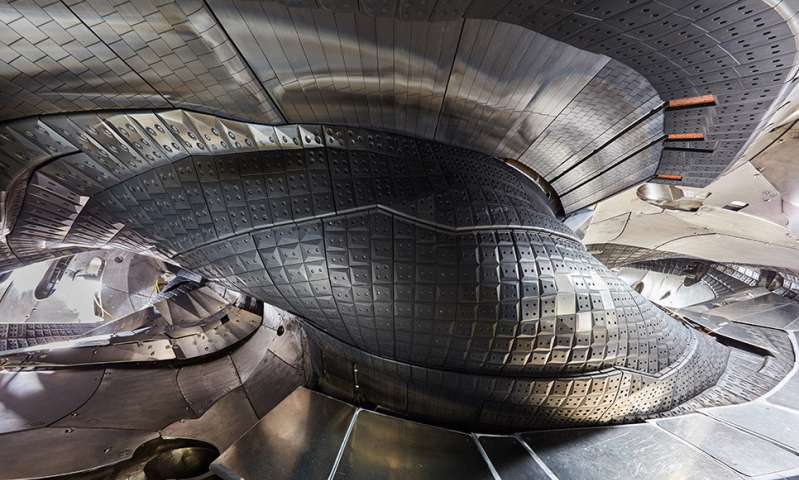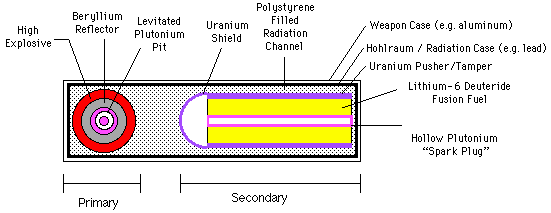Scientists have been trying to achieve stabile energy producing nuclear fusion for decades now. The dream to use the same process that produces energy in the Sun on Earth has been hard to reach because the Sun has a lot to help it do what it does. The massive star has gravity pushing its atoms together and incredible high temperatures as well. We can’t generate a gravity well similar to that of the Sun on Earth, if we could do it at all, it would probably crush our planet into elements heavier than iron instantly.

To date the solution has been to hold a plasma, which is a kind of super hot gas in which atoms are stripped of their electrons and behave a bit differenty, in a magnetic field. This requires enormous magnets and other precautions to hold the plasma in place. Ze germans have started to build so called Stellerators to deal with some inherent instabilities of the conventional donut design (shown above).

The plasma wants to twist around like a moebius strip, and rather than fight this the german researchers choose to go with the flow (literally) and build a more complex shape. The next generation of this hopes to twist the plasma four times, resulting in a nice square shape. There are other ways to do fusion but these are the two most published ones today.
Rolls Royce is readying to sell small conventional fission reactors. We better avoid that by presenting a safer fusion alternative!
The problem is that with both designs the heat generated has to go somewhere. If fusion takes place (usually not between to Hydrogen atoms but between tritium and deuterium prepared earlier), this will generate surplus heat, which radiates to the walls through the magnetic containment field holding the plasma. The wall will heat up and this heat needs to go somewhere or the wall will melt and the containment field will fail. Good thing about fusion reactors is that if that happens the reactor shuts down.
Until now, the reactors had to be pretty big, because if the heat leaves the plasma for the walls and doesn’t return the plasma cools and this inhibits the fusion process. So you can only have a fusion process in the center of the plasma that is hot enough, the likelyhood tapers off with distance from that center. A clever solution seems to have been found now, which is to use wall that is already molten.

The idea is to use Lithium, the metal also used to make some of the fuel for the fusion, as some kind of absorber. The plasma would come very close to the lithium, the hydrogen and other fusion constintuents could actually hit it and be absorbed. Importantly, if the Lithium evaporates it would not be much of a problem for the fusion proces.
The idea is to use the Lithium as some kind of cooling fluid that constantly flows along the outside of the reactor. This can be achieved by inherent effects of metals, namely the effect that two metals that touch, when hot, generate a potential, and that liquid that has a potential and thus a current through it will move in a magnetic field. This would assumedly keep the Lithium flowing along a stainless steel structured wall.
The beauty of this approach is not only that you end up with a way to contain the plasma and extract the produced heat, but also that you increase the space that is hot enough for fusion. The plasma would almost touch the Lithium. This in turn allowes for fusion reactors that are 20 times smaller! That is not only cheaper but probably also more simple to manage.

If you have learned anything about nuclear power, fussion or fission, it is contained in the above image. It shows the energy that nuclei have, and it shows that lighter elements like to fuse, and heavier elements like to fiss (split up). It turns out however that you can split light atoms, and nuclear fusion reactors need this to be possible. This is because hydrogen fusion is much more difficult than other related types of fusion. Lithium 6 and 7 are such light atoms that are easy to split, and are being split to produce Tritium. Funnily this produces quite an amount of energy.
Fun fact ” Tritium has leaked from 48 of 65 nuclear sites in the US. In one case, leaking water contained 7.5 microcuries (280 kBq) of tritium per litre, which is 375 times the EPA limit for drinking water.” “God damnit nuclear power!
Splitting Lithium has been propsed as a way to build a rocket engine. So much energy is released if Lithium is split that you have quite a lot of force at your disposal. The question is how to do it. The experts thought about it and one proposal is to have a cavity with Uranium in it, this would produce the neutrons necessary to split the Lithium. The Lithium would then be pumped into the cavity where it would split and enormous amounts of energy would heat it up, it would expand and blow out the back of the cavity.

“The advantages over conventional rockets are stupidly high specific impulse and thrust” perhaps a quicker way to get to Mars?
The above shows the rocket engine design. It would be quite safe but not on Earth. It seems that once there is a use for Tritium in fusion reactors one could also produce more of this gas from Lithium reactors. The simplest way to do this would be to add Lithium to existing nuclear reactors. It would heat up and the turbines would run as the Lithum 6 and 7 break up. This has actually been proposed but probably because of the risk of Tritium gas, which is harmfull when inhaled, we have not seen any real world implementation.

We don’t know the details so we asked the professor if the Lithium in the fusion reactor would pose a risk, that is of splitting. We hope he has an encouraging answer 
Fusion reactors are being held out like a world saving carrot sometimes, being clean and safe and indepletable. The Stellerator tests, with or without Lithium walls, will continue this year, and promises to be the cheaper option. If it can be downsized it will be even more convienient. It would be nice to see the real deal some time soon. If we can use carbon free energy sources to build theoretically infinite amounts of solar panels and do whatever we need to for our oceans, that would be a blessing.